Dogs are cherished companions, bringing immense joy and unconditional love into our lives. However, for many individuals, the dream of pet parenthood is often clouded by the reality of pet allergies. While the term “hypoallergenic dog” frequently comes up in conversations about allergy-friendly pets, it’s essential to understand what this truly means and which breeds are best suited for those seeking a list of dogs that don’t shed hair. This comprehensive guide will delve into the world of low-shedding breeds, offering insights into their unique coats, temperaments, and essential care tips to help you find your perfect canine companion without the sneeze.
Understanding “Hypoallergenic” Dogs and Why They Shed Less
The concept of a “hypoallergenic dog” is often misunderstood. The truth is, no dog is 100% allergen-free. Allergies to dogs are typically triggered by dander (flakes of dead skin), saliva, and urine, rather than just the hair itself. These microscopic allergens become airborne or attach to surfaces, causing reactions in sensitive individuals.
What makes certain breeds “hypoallergenic” or low-shedding is their unique coat type. These dogs tend to have a single coat (no undercoat), or a hair-like coat that grows continuously, much like human hair, rather than shedding in cycles. This means they release significantly less dander and loose hair into the environment compared to heavy-shedding breeds. As a result, fewer allergens are dispersed, making them a better fit for people with mild to moderate dog allergies. When considering your ideal companion, exploring options from a comprehensive list of dogs that don’t shed hair can be a crucial first step.
Top Dog Breeds That Don’t Shed Hair (or Shed Minimally)
While no dog is completely non-shedding, the breeds listed below are known for their minimal shedding and are often recommended for allergy sufferers. Each offers a unique blend of size, temperament, and grooming needs.
1. Poodle
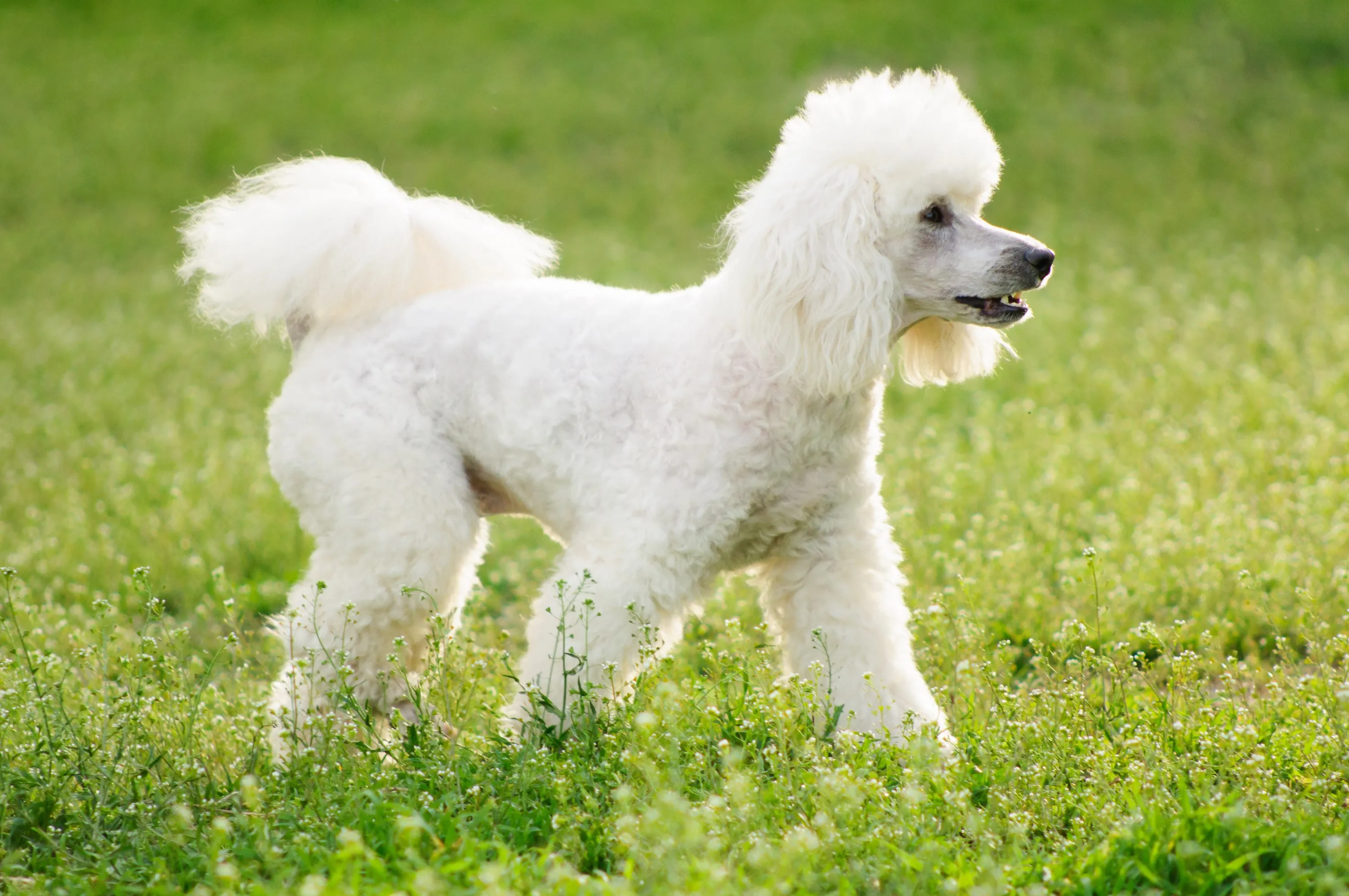 White Poodle walking through green grassPoodles are renowned for their intelligence and distinctive curly coats, which are a major reason they feature prominently on any list of dogs that don’t shed hair. Available in Standard, Miniature, and Toy sizes, they can fit various lifestyles. Their dense, curly coat traps loose hair and dander, preventing it from spreading around the home. However, this also means their coat requires diligent grooming, including regular brushing to prevent matting and professional clipping every 4-6 weeks. Poodles are highly trainable, active, and enjoy being involved in family activities, making them versatile companions.
White Poodle walking through green grassPoodles are renowned for their intelligence and distinctive curly coats, which are a major reason they feature prominently on any list of dogs that don’t shed hair. Available in Standard, Miniature, and Toy sizes, they can fit various lifestyles. Their dense, curly coat traps loose hair and dander, preventing it from spreading around the home. However, this also means their coat requires diligent grooming, including regular brushing to prevent matting and professional clipping every 4-6 weeks. Poodles are highly trainable, active, and enjoy being involved in family activities, making them versatile companions.
2. Yorkshire Terrier
 Blue and tan Yorkshire Terrier lounging on an armchairSmall in stature but big in personality, the Yorkshire Terrier, or Yorkie, is a popular choice among little dog breeds that don’t shed. Their fine, silky, human-like hair sheds minimally, making them a great option for allergy sufferers. Yorkies are known for their spunky, confident, and affectionate nature. They adapt well to apartment living but thrive on attention and daily walks. Regular brushing is essential to keep their long coats tangle-free and healthy.
Blue and tan Yorkshire Terrier lounging on an armchairSmall in stature but big in personality, the Yorkshire Terrier, or Yorkie, is a popular choice among little dog breeds that don’t shed. Their fine, silky, human-like hair sheds minimally, making them a great option for allergy sufferers. Yorkies are known for their spunky, confident, and affectionate nature. They adapt well to apartment living but thrive on attention and daily walks. Regular brushing is essential to keep their long coats tangle-free and healthy.
3. Shih Tzu
 Brown and white Shih Tzu lying on a living room floorThe Shih Tzu is an ancient companion breed celebrated for its friendly temperament and luxurious, flowing double coat that paradoxically sheds very little. Despite their thick hair, they are often included on a list of dogs that don’t shed hair due to the nature of their coat, which holds onto loose strands. This means daily brushing is critical to prevent mats and tangles. Their flat faces can predispose them to certain health issues like overheating and breathing problems, so owners should be mindful of temperature and exercise. Shih Tzus are adaptable and loving, making them excellent lap dogs.
Brown and white Shih Tzu lying on a living room floorThe Shih Tzu is an ancient companion breed celebrated for its friendly temperament and luxurious, flowing double coat that paradoxically sheds very little. Despite their thick hair, they are often included on a list of dogs that don’t shed hair due to the nature of their coat, which holds onto loose strands. This means daily brushing is critical to prevent mats and tangles. Their flat faces can predispose them to certain health issues like overheating and breathing problems, so owners should be mindful of temperature and exercise. Shih Tzus are adaptable and loving, making them excellent lap dogs.
4. Miniature Schnauzer
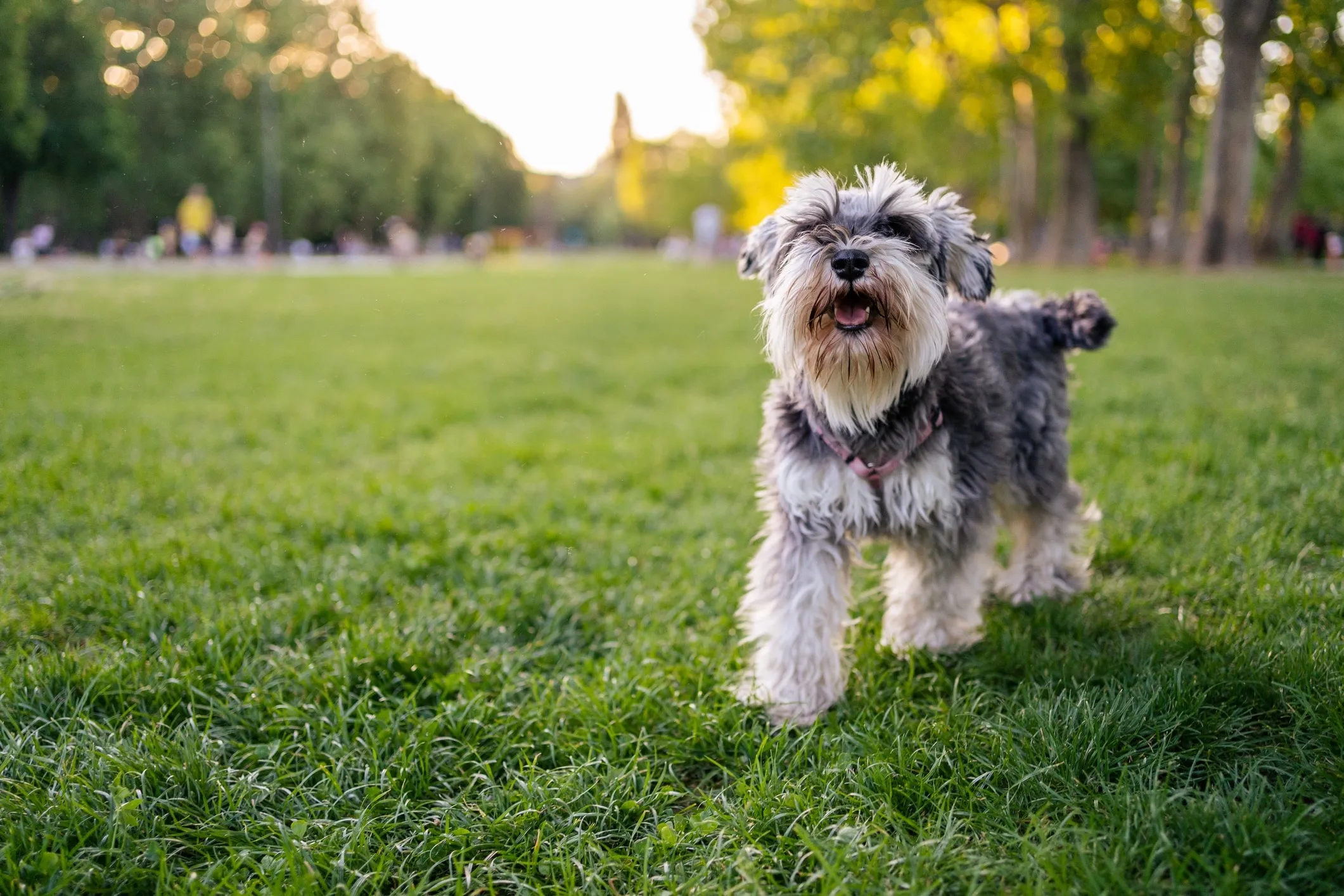 Salt and pepper Miniature Schnauzer wearing a pink harness in a parkThe Miniature Schnauzer is a robust, intelligent, and spirited terrier that fits well into many homes. Standing no more than 14 inches tall, they possess a wiry outer coat and a soft undercoat, which contribute to their minimal shedding. Regular hand-stripping or clipping is necessary to maintain their coat’s texture and reduce shedding. Miniature Schnauzers are alert, playful, and require at least an hour of exercise daily to keep them happy and mentally stimulated.
Salt and pepper Miniature Schnauzer wearing a pink harness in a parkThe Miniature Schnauzer is a robust, intelligent, and spirited terrier that fits well into many homes. Standing no more than 14 inches tall, they possess a wiry outer coat and a soft undercoat, which contribute to their minimal shedding. Regular hand-stripping or clipping is necessary to maintain their coat’s texture and reduce shedding. Miniature Schnauzers are alert, playful, and require at least an hour of exercise daily to keep them happy and mentally stimulated.
5. Standard Schnauzer
 Gray Standard Schnauzer standing in a fieldSharing many desirable traits with their miniature counterparts, the Standard Schnauzer is a larger, more powerful version. Their dense, wiry coat also contributes to their low-shedding reputation, placing them firmly on a list of dogs that don’t shed hair. These loyal and protective dogs can weigh up to 45 pounds and thrive on activity, needing plenty of opportunities for long walks, games of fetch, and mental challenges. Like the Miniature Schnauzer, their coat requires regular grooming, including brushing and occasional hand-stripping or professional trimming.
Gray Standard Schnauzer standing in a fieldSharing many desirable traits with their miniature counterparts, the Standard Schnauzer is a larger, more powerful version. Their dense, wiry coat also contributes to their low-shedding reputation, placing them firmly on a list of dogs that don’t shed hair. These loyal and protective dogs can weigh up to 45 pounds and thrive on activity, needing plenty of opportunities for long walks, games of fetch, and mental challenges. Like the Miniature Schnauzer, their coat requires regular grooming, including brushing and occasional hand-stripping or professional trimming.
6. Giant Schnauzer
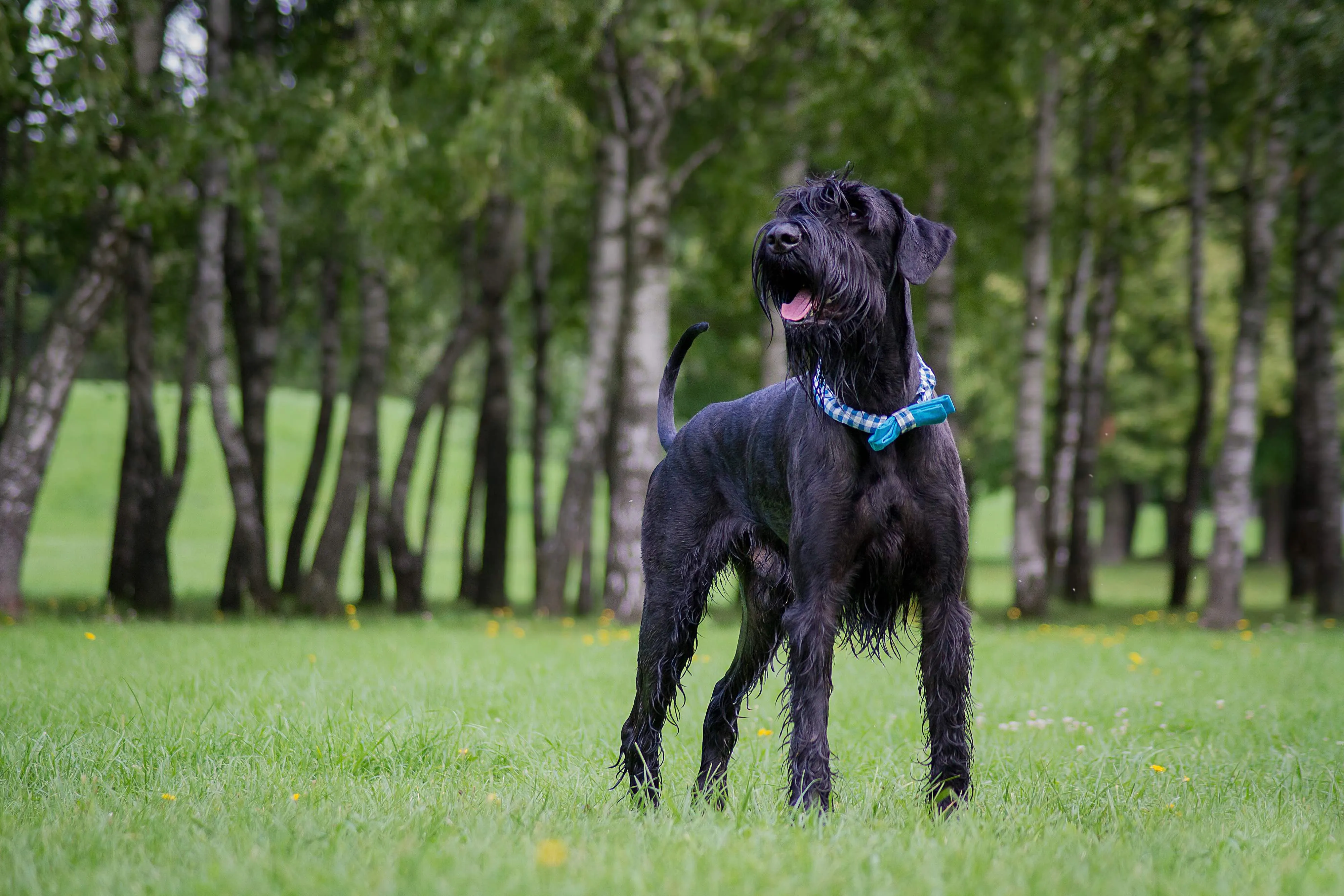 Black wet Giant Schnauzer wearing a blue bow collar standing in a parkFor those seeking a larger low-shedding companion, the Giant Schnauzer is an impressive choice. Capable of weighing up to 85 pounds, these powerful dogs possess a coarse, wiry outer coat that sheds minimally, making them one of the largest on a list of dogs that don’t shed hair. Giant Schnauzers are intelligent, courageous, and need extensive exercise and training to channel their high energy. They are fiercely loyal to their families and make excellent guardians. Regular grooming, including brushing and professional stripping/clipping, is crucial for their coat health.
Black wet Giant Schnauzer wearing a blue bow collar standing in a parkFor those seeking a larger low-shedding companion, the Giant Schnauzer is an impressive choice. Capable of weighing up to 85 pounds, these powerful dogs possess a coarse, wiry outer coat that sheds minimally, making them one of the largest on a list of dogs that don’t shed hair. Giant Schnauzers are intelligent, courageous, and need extensive exercise and training to channel their high energy. They are fiercely loyal to their families and make excellent guardians. Regular grooming, including brushing and professional stripping/clipping, is crucial for their coat health.
7. Bichon Frise
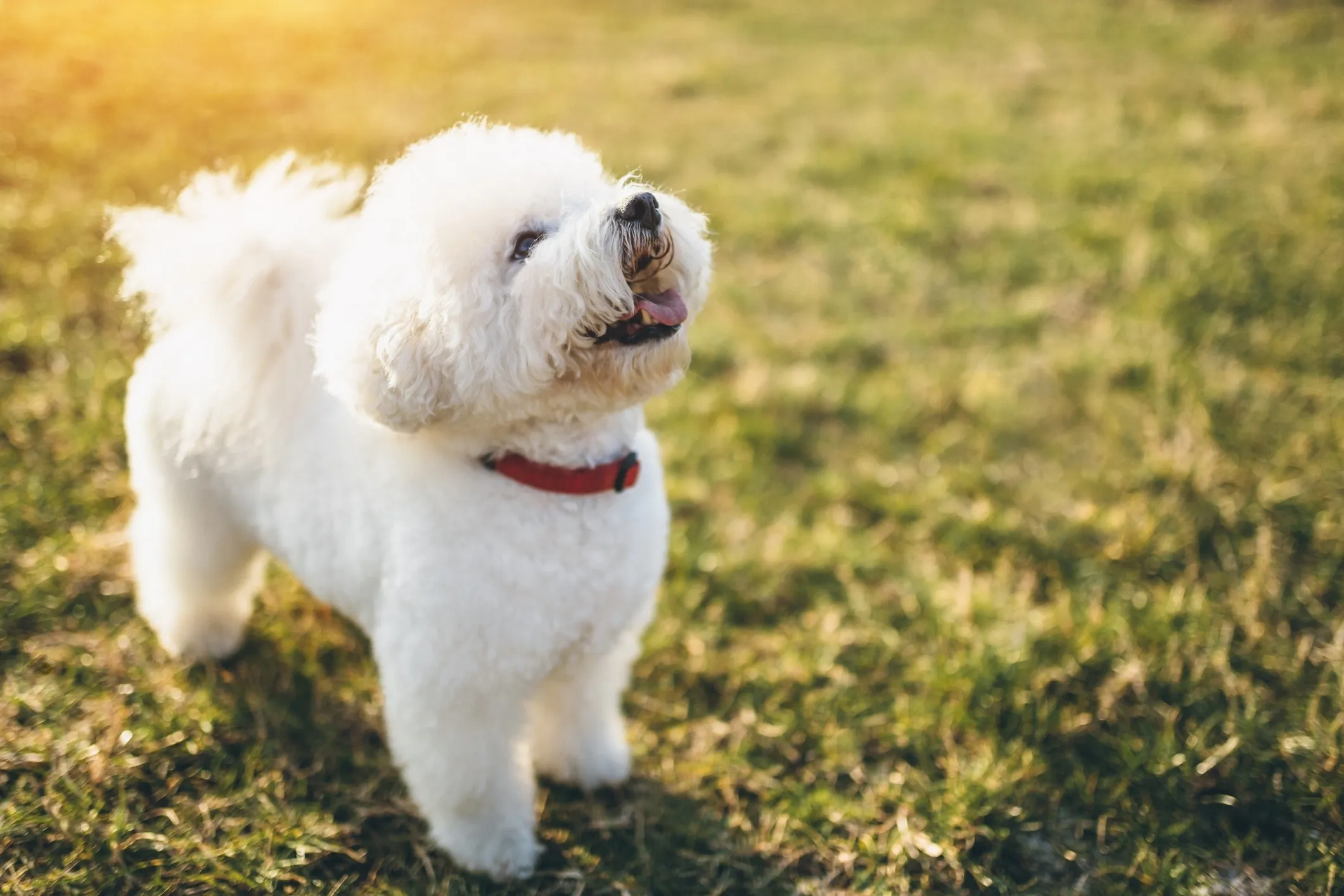 White Bichon Frise dog looking up in the grassThe Bichon Frise is a cheerful, playful, and affectionate little dog with a distinctive curly, powder-puff coat that is considered hypoallergenic. Their non-shedding coat consists of soft, dense hair that continually grows, requiring daily brushing and regular professional grooming to prevent matting. Bichons are intelligent and highly trainable, eager to please their families. They are adaptable to various living situations and make wonderful companions, especially for those looking for small smart dog breeds that don’t shed.
White Bichon Frise dog looking up in the grassThe Bichon Frise is a cheerful, playful, and affectionate little dog with a distinctive curly, powder-puff coat that is considered hypoallergenic. Their non-shedding coat consists of soft, dense hair that continually grows, requiring daily brushing and regular professional grooming to prevent matting. Bichons are intelligent and highly trainable, eager to please their families. They are adaptable to various living situations and make wonderful companions, especially for those looking for small smart dog breeds that don’t shed.
8. Chinese Crested
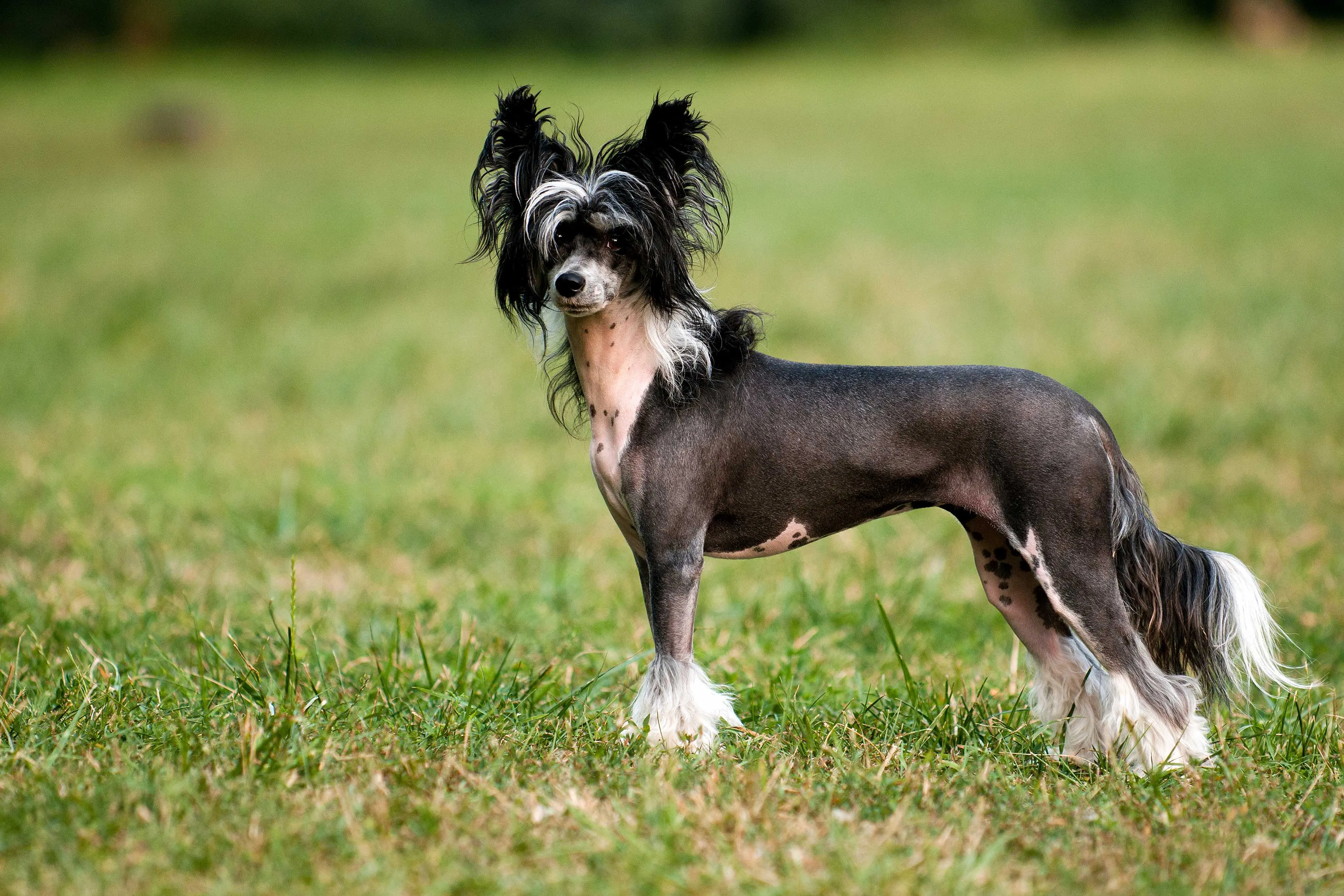 Black hairless Chinese Crested looking at the cameraKnown for their unique appearance, the Chinese Crested comes in two varieties: hairless and “powderpuff.” Both are considered low-shedding. The hairless variety has smooth skin with tufts of hair on the head, tail, and paws, making dander release minimal. The powderpuff has a full, soft, silky coat that sheds very little, similar to human hair. These small, affectionate dogs are playful and devoted to their owners, adapting well to indoor living. Skin care for the hairless variety and regular brushing for the powderpuff are essential.
Black hairless Chinese Crested looking at the cameraKnown for their unique appearance, the Chinese Crested comes in two varieties: hairless and “powderpuff.” Both are considered low-shedding. The hairless variety has smooth skin with tufts of hair on the head, tail, and paws, making dander release minimal. The powderpuff has a full, soft, silky coat that sheds very little, similar to human hair. These small, affectionate dogs are playful and devoted to their owners, adapting well to indoor living. Skin care for the hairless variety and regular brushing for the powderpuff are essential.
9. Portuguese Water Dog
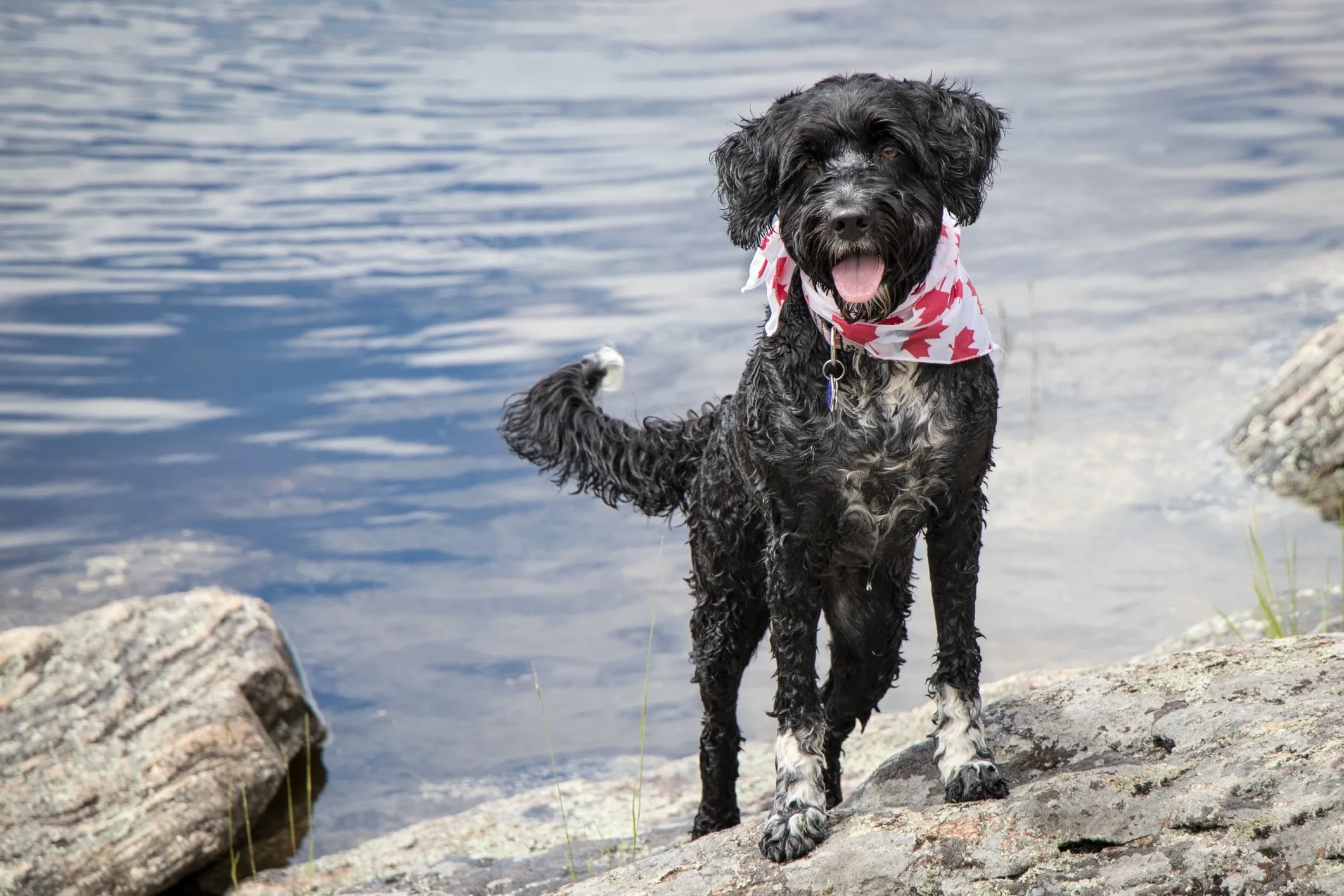 Black and white Portuguese Water Dog wearing a red maple leaf bandana in front of waterOriginally bred to assist fishermen, the Portuguese Water Dog is a robust, intelligent, and energetic breed with a dense, curly, or wavy coat that sheds very little. Their water-resistant coat makes them ideal for aquatic activities and positions them on a list of dogs that don’t shed hair. Portuguese Water Dogs are highly trainable and friendly, but their high energy levels demand regular, vigorous exercise, including swimming, to keep them healthy and happy. Regular brushing and professional grooming are essential to prevent mats.
Black and white Portuguese Water Dog wearing a red maple leaf bandana in front of waterOriginally bred to assist fishermen, the Portuguese Water Dog is a robust, intelligent, and energetic breed with a dense, curly, or wavy coat that sheds very little. Their water-resistant coat makes them ideal for aquatic activities and positions them on a list of dogs that don’t shed hair. Portuguese Water Dogs are highly trainable and friendly, but their high energy levels demand regular, vigorous exercise, including swimming, to keep them healthy and happy. Regular brushing and professional grooming are essential to prevent mats.
10. Labradoodle
 Brown Standard Labradoodle walking in a parkA popular crossbreed between a Labrador Retriever and a Poodle, the Labradoodle was originally developed as a hypoallergenic service dog. Their coats can vary from wavy to curly, with the curlier types being less prone to shedding. Labradoodles are known for their intelligent, friendly, and gentle nature, making them excellent family pets. They are highly trainable and, with proper socialization and exercise, are wonderful companions. Regular grooming is necessary to maintain their coat and prevent matting.
Brown Standard Labradoodle walking in a parkA popular crossbreed between a Labrador Retriever and a Poodle, the Labradoodle was originally developed as a hypoallergenic service dog. Their coats can vary from wavy to curly, with the curlier types being less prone to shedding. Labradoodles are known for their intelligent, friendly, and gentle nature, making them excellent family pets. They are highly trainable and, with proper socialization and exercise, are wonderful companions. Regular grooming is necessary to maintain their coat and prevent matting.
11. Goldendoodle
 Goldendoodle lying on a couch with a person sitting in the backgroundAnother beloved “doodle” breed, the Goldendoodle is a cross between a Golden Retriever and a Poodle. Like the Labradoodle, their low-shedding coats (especially curlier varieties) make them suitable for allergy sufferers. Goldendoodles inherit a friendly nature and high intelligence from both parent breeds. They are energetic and require regular exercise and mental stimulation. Their coats come in various colors and textures and need frequent brushing to prevent tangles and mats.
Goldendoodle lying on a couch with a person sitting in the backgroundAnother beloved “doodle” breed, the Goldendoodle is a cross between a Golden Retriever and a Poodle. Like the Labradoodle, their low-shedding coats (especially curlier varieties) make them suitable for allergy sufferers. Goldendoodles inherit a friendly nature and high intelligence from both parent breeds. They are energetic and require regular exercise and mental stimulation. Their coats come in various colors and textures and need frequent brushing to prevent tangles and mats.
12. Lagotto Romagnolo
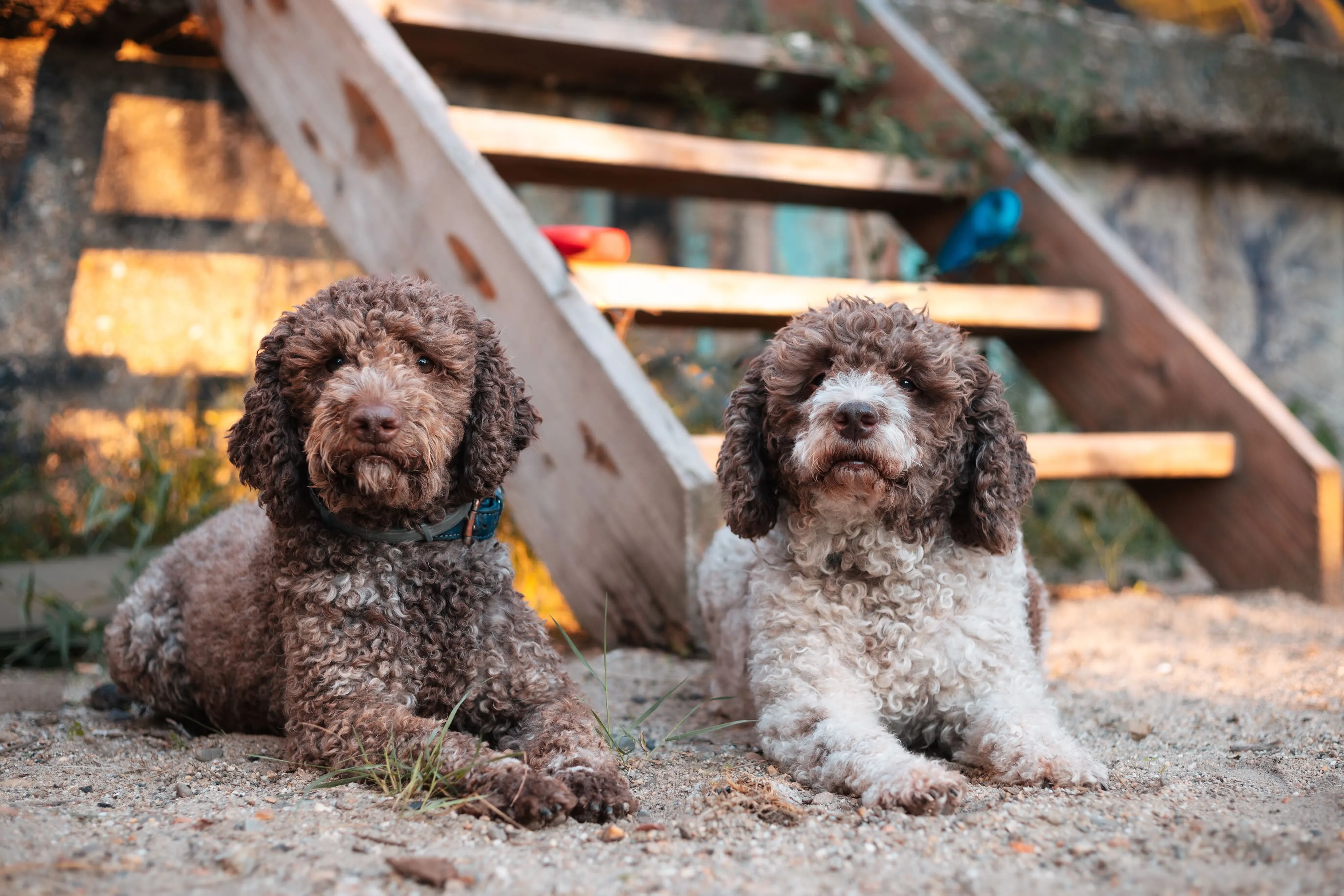 Two Lagotto Romagnolo dogs lying in dirt staring at the cameraHailing from Italy, the Lagotto Romagnolo was originally bred as a water retriever and truffle hunter. Their curly, woolly coat is dense and waterproof, shedding minimally and offering protection in chilly waters. These intelligent dogs are generally good with children and other pets, making them adaptable family dogs. Regular clipping and occasional hand-stripping are required to maintain their unique coat texture and keep it healthy.
Two Lagotto Romagnolo dogs lying in dirt staring at the cameraHailing from Italy, the Lagotto Romagnolo was originally bred as a water retriever and truffle hunter. Their curly, woolly coat is dense and waterproof, shedding minimally and offering protection in chilly waters. These intelligent dogs are generally good with children and other pets, making them adaptable family dogs. Regular clipping and occasional hand-stripping are required to maintain their unique coat texture and keep it healthy.
13. Affenpinscher
 Black Affenpinscher dog close-upAffenpinschers are small, charming dogs known for their distinctive monkey-like expressions. Their dense, wiry, rough coat contributes to their low-shedding quality. While they shed less than many breeds, their coat requires regular care, including at-home brushing and occasional hand-stripping by a professional to remove dead hair from the root. Affenpinschers are confident, curious, and make loyal companions, often possessing a strong sense of humor.
Black Affenpinscher dog close-upAffenpinschers are small, charming dogs known for their distinctive monkey-like expressions. Their dense, wiry, rough coat contributes to their low-shedding quality. While they shed less than many breeds, their coat requires regular care, including at-home brushing and occasional hand-stripping by a professional to remove dead hair from the root. Affenpinschers are confident, curious, and make loyal companions, often possessing a strong sense of humor.
14. Irish Water Spaniel
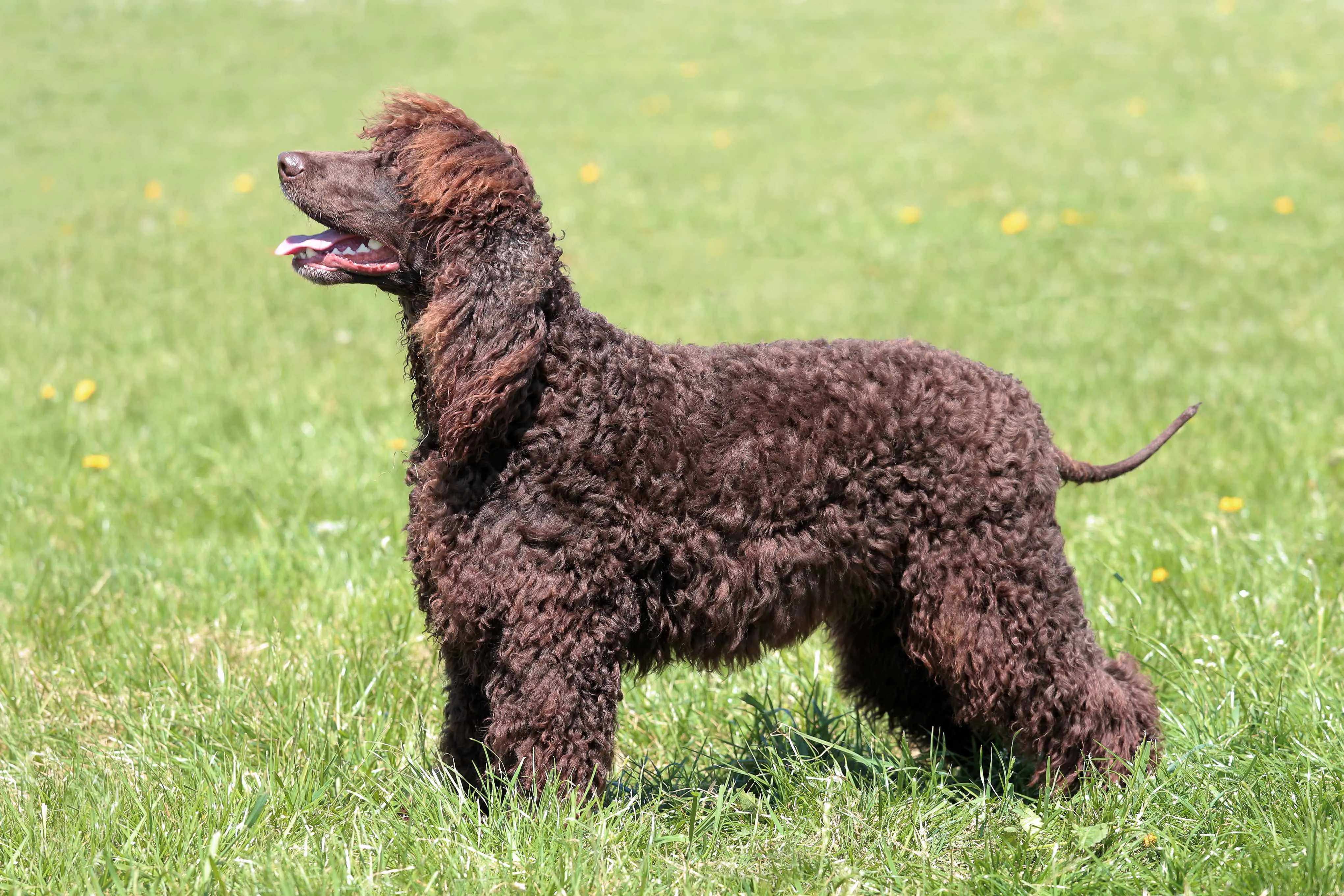 Brown Irish Water Spaniel profileThe Irish Water Spaniel is a distinctive, large sporting dog with a unique “rat tail” and a thick, curly, waterproof coat that sheds minimally. Known for their intelligence, friendliness, and high trainability, these dogs were bred for retrieving game from water. Their liver-colored coat requires regular brushing and trimming to prevent matting. With high energy levels, Irish Water Spaniels need ample exercise to stay happy and healthy, thriving on activities that challenge both their bodies and minds.
Brown Irish Water Spaniel profileThe Irish Water Spaniel is a distinctive, large sporting dog with a unique “rat tail” and a thick, curly, waterproof coat that sheds minimally. Known for their intelligence, friendliness, and high trainability, these dogs were bred for retrieving game from water. Their liver-colored coat requires regular brushing and trimming to prevent matting. With high energy levels, Irish Water Spaniels need ample exercise to stay happy and healthy, thriving on activities that challenge both their bodies and minds.
15. Aussiedoodle
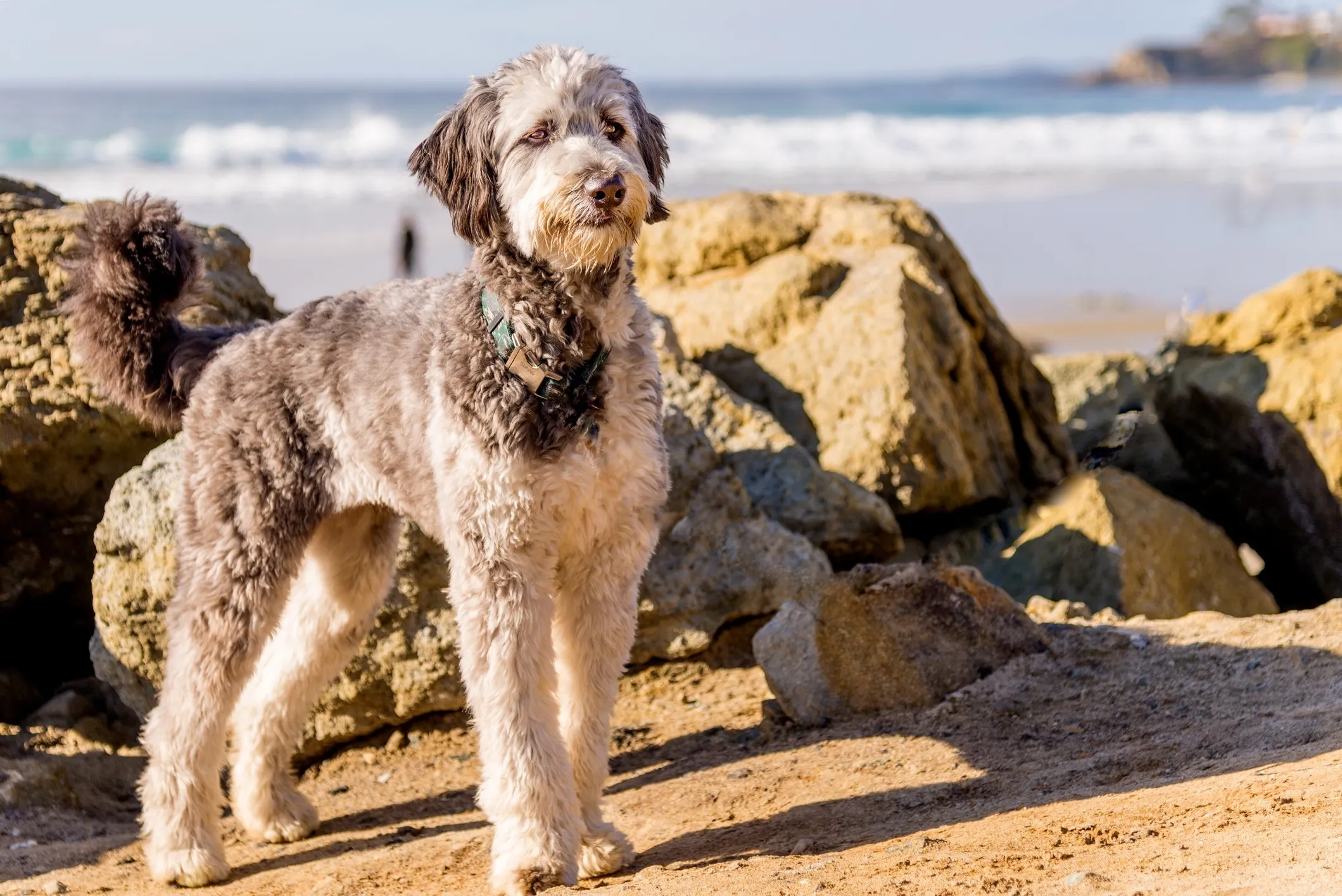 Standard Aussiedoodle dog standing on a beachA cross between an Australian Shepherd and a Poodle, the Aussiedoodle is a highly intelligent and energetic dog. Their coat typically features the low-shedding qualities of the Poodle, making them a desirable addition to a list of dogs that don’t shed hair. Aussiedoodles thrive on activity and mental stimulation; without it, they can become destructive. They are affectionate and eager to please, often excelling in dog sports. Regular grooming, including brushing and trimming, is essential for their varying coat types.
Standard Aussiedoodle dog standing on a beachA cross between an Australian Shepherd and a Poodle, the Aussiedoodle is a highly intelligent and energetic dog. Their coat typically features the low-shedding qualities of the Poodle, making them a desirable addition to a list of dogs that don’t shed hair. Aussiedoodles thrive on activity and mental stimulation; without it, they can become destructive. They are affectionate and eager to please, often excelling in dog sports. Regular grooming, including brushing and trimming, is essential for their varying coat types.
16. Bolognese
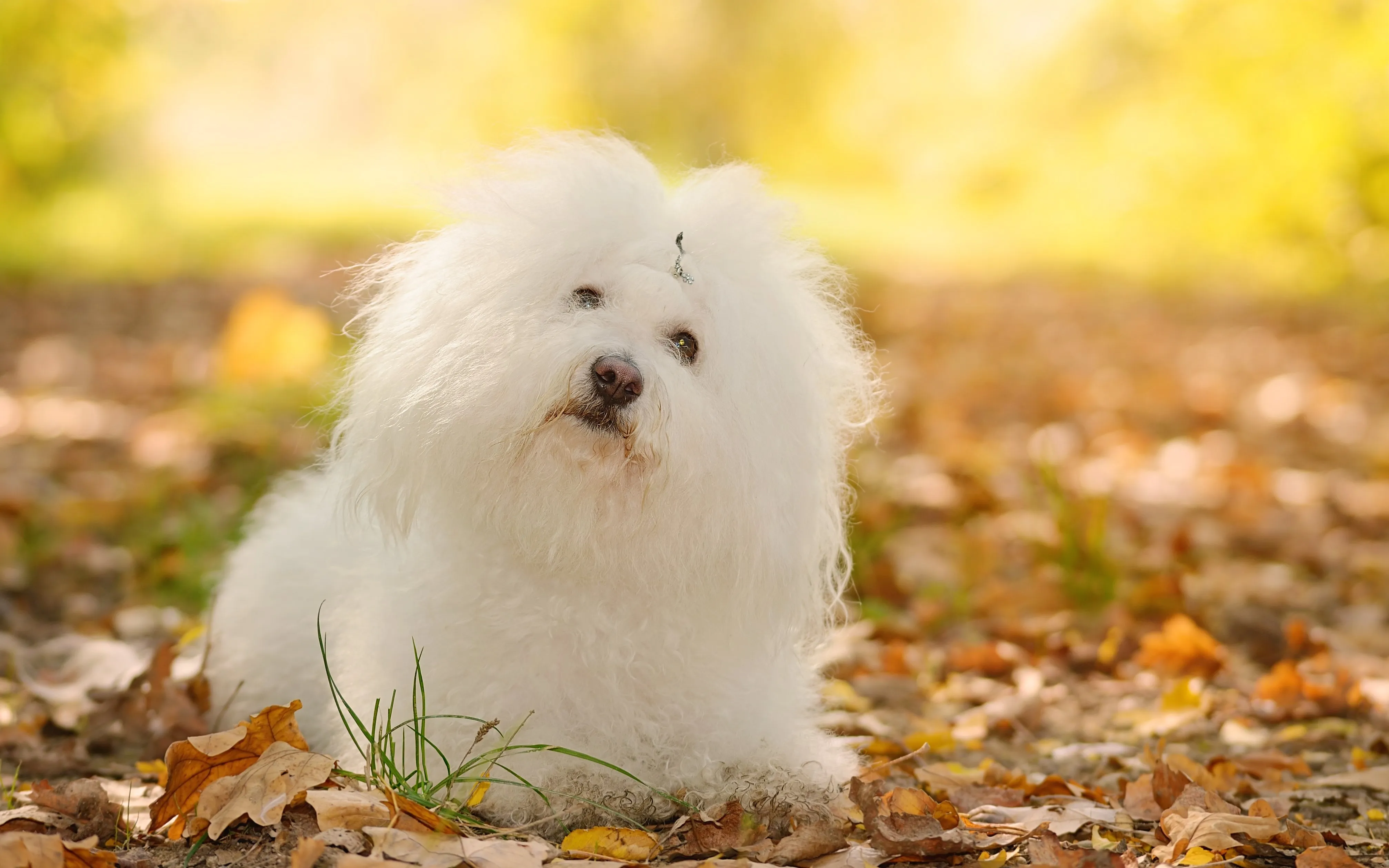 White Bolognese dog sitting in an autumn forestOriginating from Italy, the Bolognese is a charming and cute small dog with a long, fluffy white coat that, despite its appearance, sheds very little. This makes them a great candidate for allergy sufferers. Bolognese are playful, easygoing, and generally get along well with children and other pets. Their characteristic messy coat requires consistent grooming, including daily brushing, to prevent mats and keep it looking its best. They are adaptable to various living situations, from apartments to larger homes.
White Bolognese dog sitting in an autumn forestOriginating from Italy, the Bolognese is a charming and cute small dog with a long, fluffy white coat that, despite its appearance, sheds very little. This makes them a great candidate for allergy sufferers. Bolognese are playful, easygoing, and generally get along well with children and other pets. Their characteristic messy coat requires consistent grooming, including daily brushing, to prevent mats and keep it looking its best. They are adaptable to various living situations, from apartments to larger homes.
17. Maltese
 Woman holding a white Maltese dog on a bedThe Maltese is a small, aristocratic dog renowned for its long, silky white coat that sheds minimally. These affectionate and playful companions thrive on human interaction. While their luxurious coat is a hallmark of the breed, it requires significant grooming, including daily brushing, to prevent tangles and maintain its pristine condition. Many owners opt for a shorter “puppy cut” to simplify grooming. Maltese are adaptable and can be perfect lap dogs for attentive owners.
Woman holding a white Maltese dog on a bedThe Maltese is a small, aristocratic dog renowned for its long, silky white coat that sheds minimally. These affectionate and playful companions thrive on human interaction. While their luxurious coat is a hallmark of the breed, it requires significant grooming, including daily brushing, to prevent tangles and maintain its pristine condition. Many owners opt for a shorter “puppy cut” to simplify grooming. Maltese are adaptable and can be perfect lap dogs for attentive owners.
18. Soft Coated Wheaten Terrier
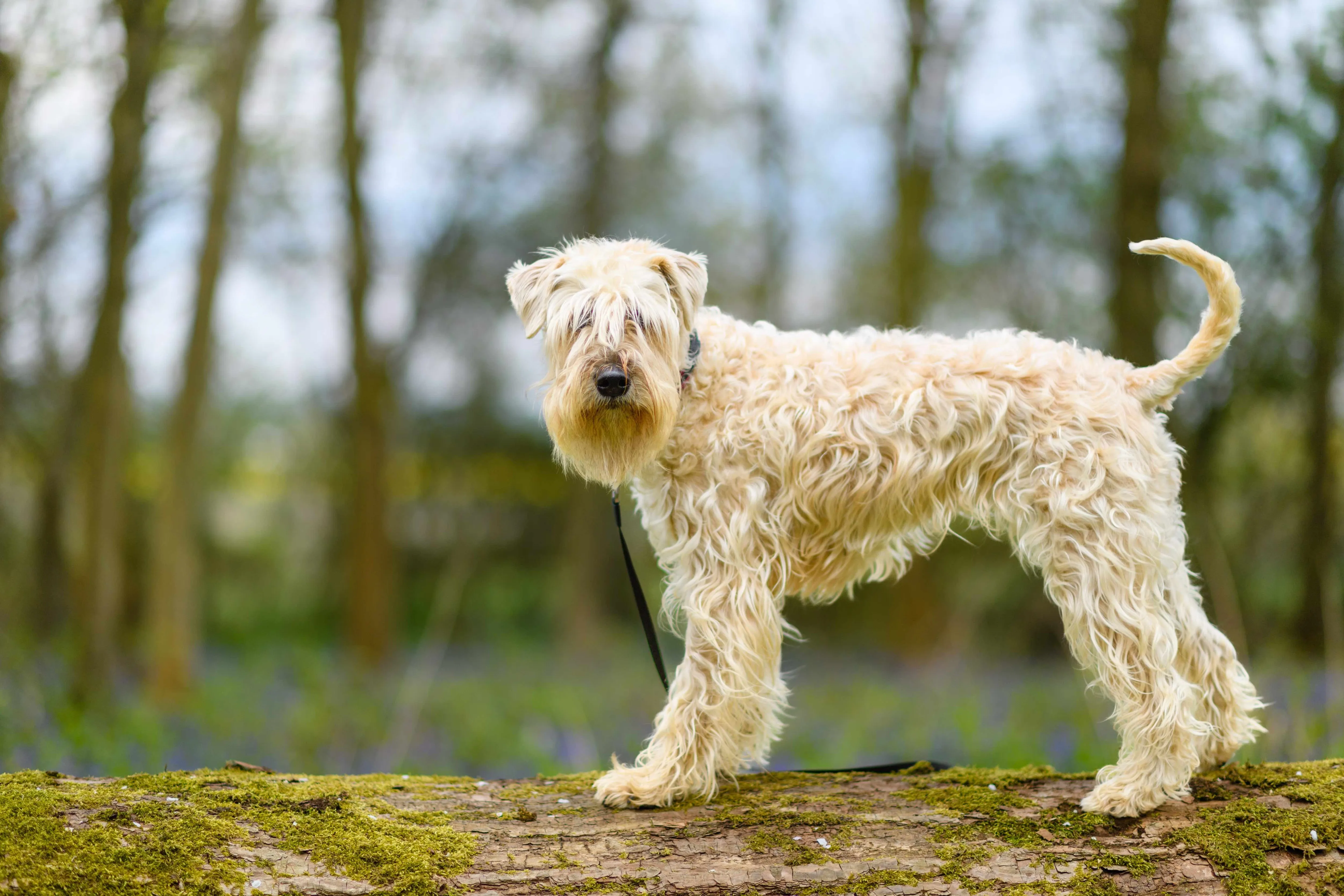 Soft Coated Wheaten Terrier dog on a logThe Soft Coated Wheaten Terrier is a medium-sized Irish breed known for its incredibly soft, silky coat that sheds very little, hence its inclusion on a list of dogs that don’t shed hair. These high-energy terriers maintain their youthful exuberance throughout their lives, requiring ample exercise and mental stimulation to prevent boredom. Wheatens are cheerful, friendly, and devoted to their families, often greeting them with their famous “Wheaten Greetin'” — an enthusiastic jump and lick. Regular brushing and occasional trimming are necessary to keep their unique coat healthy and free of mats. This breed is known for being among the gentle dog breeds that don’t shed.
Soft Coated Wheaten Terrier dog on a logThe Soft Coated Wheaten Terrier is a medium-sized Irish breed known for its incredibly soft, silky coat that sheds very little, hence its inclusion on a list of dogs that don’t shed hair. These high-energy terriers maintain their youthful exuberance throughout their lives, requiring ample exercise and mental stimulation to prevent boredom. Wheatens are cheerful, friendly, and devoted to their families, often greeting them with their famous “Wheaten Greetin'” — an enthusiastic jump and lick. Regular brushing and occasional trimming are necessary to keep their unique coat healthy and free of mats. This breed is known for being among the gentle dog breeds that don’t shed.
19. Coton de Tulear
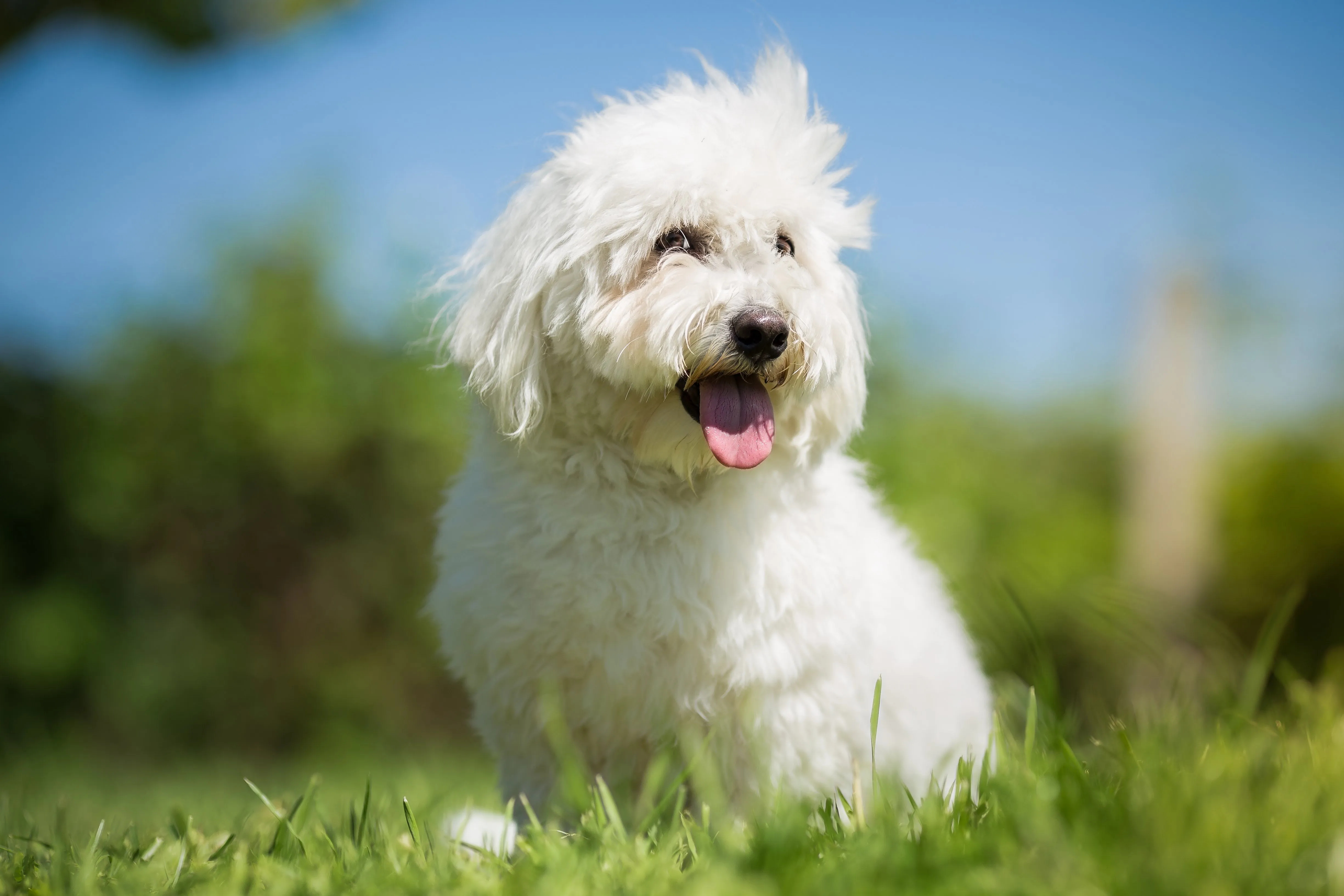 White Coton de Tulear sitting in grass with hair blowing in the windOriginating from Madagascar, the Coton de Tulear is a small, charming dog with a soft, cotton-like coat that sheds minimally. Their good-natured and affectionate personality makes them excellent family pets, often getting along well with children and other pets when properly introduced. Cotons are playful and intelligent, enjoying companionship and light exercise. Their distinctive coat requires daily brushing to prevent matting and maintain its fluffy texture.
White Coton de Tulear sitting in grass with hair blowing in the windOriginating from Madagascar, the Coton de Tulear is a small, charming dog with a soft, cotton-like coat that sheds minimally. Their good-natured and affectionate personality makes them excellent family pets, often getting along well with children and other pets when properly introduced. Cotons are playful and intelligent, enjoying companionship and light exercise. Their distinctive coat requires daily brushing to prevent matting and maintain its fluffy texture.
20. Schnoodle
 Gray Schnoodle close-upThe Schnoodle is a designer breed resulting from crossing two low-shedding breeds: the Schnauzer and the Poodle. This combination often results in a dog with a low-shedding, wavy or curly coat, making them an ideal choice for allergy sufferers. Schnoodles inherit intelligence, playfulness, and an affectionate nature from both parent breeds. Their grooming needs vary depending on coat type but generally include regular brushing and professional trimming to keep them tidy and mat-free.
Gray Schnoodle close-upThe Schnoodle is a designer breed resulting from crossing two low-shedding breeds: the Schnauzer and the Poodle. This combination often results in a dog with a low-shedding, wavy or curly coat, making them an ideal choice for allergy sufferers. Schnoodles inherit intelligence, playfulness, and an affectionate nature from both parent breeds. Their grooming needs vary depending on coat type but generally include regular brushing and professional trimming to keep them tidy and mat-free.
21. Bedlington Terrier
 White Bedlington Terrier running through snowOften described as a “lamb in dog’s clothing,” the Bedlington Terrier is a distinctive breed with a curly, woolly coat that is low-shedding. Known for their unique topknot and graceful appearance, Bedlingtons are affectionate and devoted companions. They thrive on being close to their people and can develop separation anxiety if left alone for extended periods. Their coat requires regular brushing and professional clipping to maintain its unique texture and shape.
White Bedlington Terrier running through snowOften described as a “lamb in dog’s clothing,” the Bedlington Terrier is a distinctive breed with a curly, woolly coat that is low-shedding. Known for their unique topknot and graceful appearance, Bedlingtons are affectionate and devoted companions. They thrive on being close to their people and can develop separation anxiety if left alone for extended periods. Their coat requires regular brushing and professional clipping to maintain its unique texture and shape.
22. Xoloitzcuintli
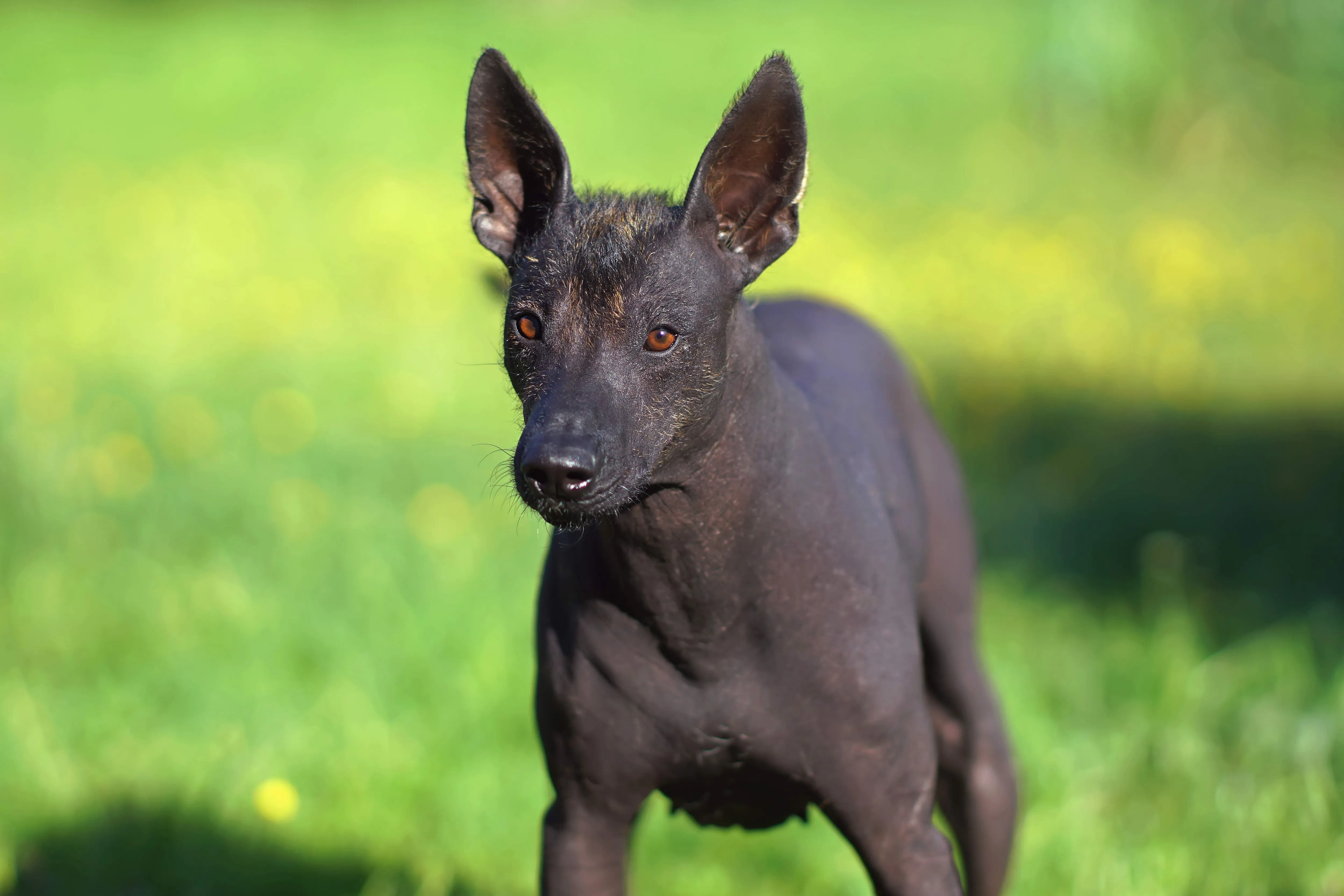 Black Mexican Hairless Dog standing in grassAlso known as the Mexican Hairless Dog, the Xoloitzcuintli is an ancient and rare breed. They come in three sizes (toy, miniature, and standard) and can be hairless or coated. Both varieties are considered hypoallergenic. The hairless Xolo has smooth, soft skin that requires protection from sun and cold, while the coated variety has a short, dense coat that sheds very little. Xolos are calm, alert, and intensely loyal, forming strong bonds with their families.
Black Mexican Hairless Dog standing in grassAlso known as the Mexican Hairless Dog, the Xoloitzcuintli is an ancient and rare breed. They come in three sizes (toy, miniature, and standard) and can be hairless or coated. Both varieties are considered hypoallergenic. The hairless Xolo has smooth, soft skin that requires protection from sun and cold, while the coated variety has a short, dense coat that sheds very little. Xolos are calm, alert, and intensely loyal, forming strong bonds with their families.
23. Whoodle
 Tan Whoodle puppy dragging a washclothA delightful cross between a Soft-Coated Wheaten Terrier and a Poodle, the Whoodle combines the intelligence and affectionate nature of both parent breeds. Their coat typically leans towards the low-shedding Poodle side, making them a good option for allergy-prone households. Whoodles are friendly, playful, and energetic dogs that enjoy being active with their families. Regular brushing and professional grooming are essential to manage their soft, wavy to curly coats.
Tan Whoodle puppy dragging a washclothA delightful cross between a Soft-Coated Wheaten Terrier and a Poodle, the Whoodle combines the intelligence and affectionate nature of both parent breeds. Their coat typically leans towards the low-shedding Poodle side, making them a good option for allergy-prone households. Whoodles are friendly, playful, and energetic dogs that enjoy being active with their families. Regular brushing and professional grooming are essential to manage their soft, wavy to curly coats.
24. Bernedoodle
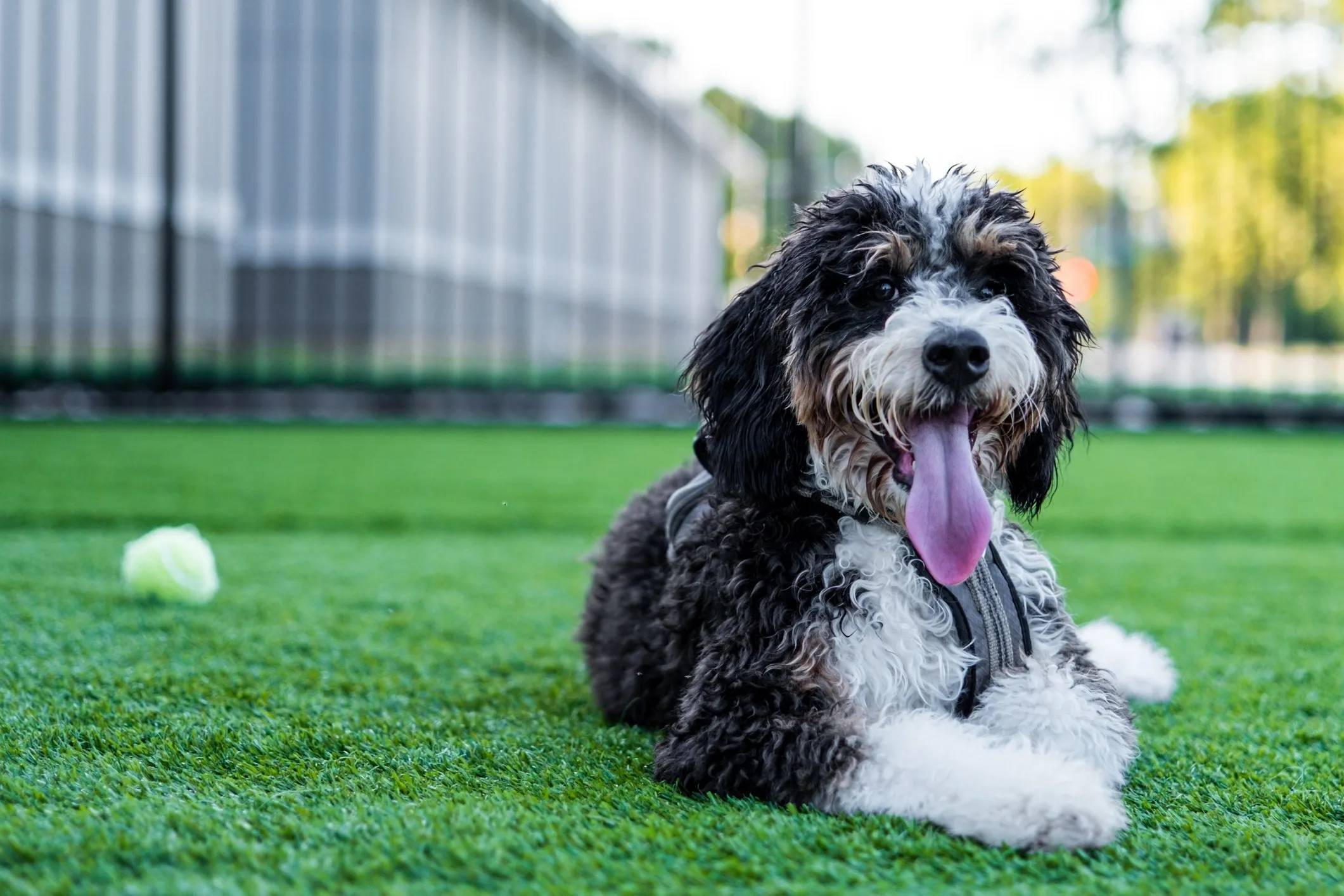 Large Bernedoodle dog lying in grass with his tongue outThe Bernedoodle is a crossbreed of the Bernese Mountain Dog and the Poodle, often resulting in a large, gentle dog with a low-shedding coat. Their friendly, affectionate nature and calm demeanor make them a popular choice for families looking for large family dogs that don’t shed. Bernedoodles need regular exercise to stay active and healthy. Their coat types can vary, but regular brushing and professional grooming are typically required to prevent matting and keep their coat in good condition.
Large Bernedoodle dog lying in grass with his tongue outThe Bernedoodle is a crossbreed of the Bernese Mountain Dog and the Poodle, often resulting in a large, gentle dog with a low-shedding coat. Their friendly, affectionate nature and calm demeanor make them a popular choice for families looking for large family dogs that don’t shed. Bernedoodles need regular exercise to stay active and healthy. Their coat types can vary, but regular brushing and professional grooming are typically required to prevent matting and keep their coat in good condition.
25. Shorkie
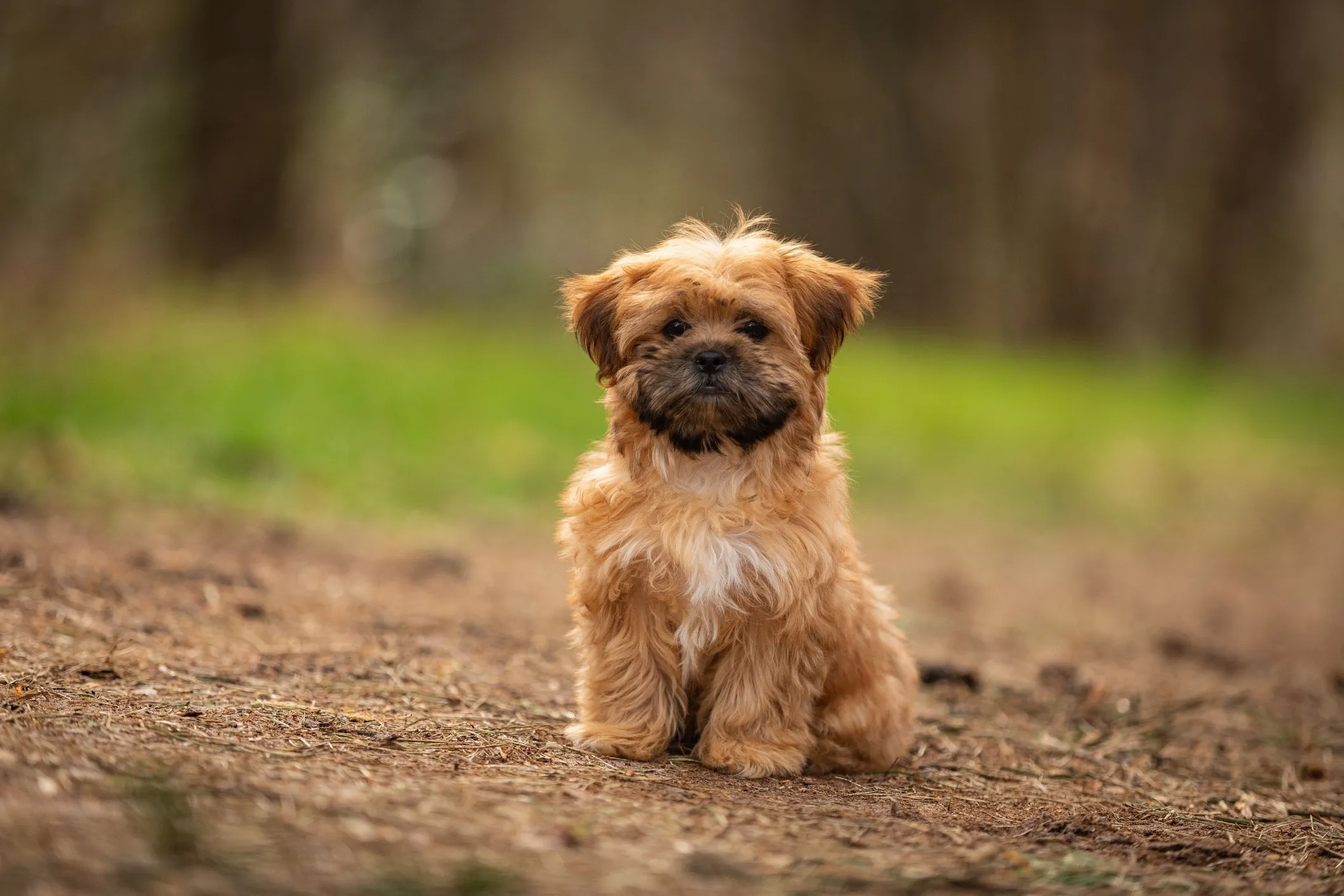 Tan and black Shih Tzu and Yorkie mix sitting on a hiking trailThe Shorkie is a charming mixed breed, combining the best traits of two low-shedding dogs: the Shih Tzu and the Yorkshire Terrier. These small dogs are playful, friendly, and thrive on companionship. Their coat, typically long and silky, requires consistent grooming, including daily brushing, to prevent tangles and mats. Shorkies are adaptable and make delightful lap dogs for owners dedicated to their grooming needs.
Tan and black Shih Tzu and Yorkie mix sitting on a hiking trailThe Shorkie is a charming mixed breed, combining the best traits of two low-shedding dogs: the Shih Tzu and the Yorkshire Terrier. These small dogs are playful, friendly, and thrive on companionship. Their coat, typically long and silky, requires consistent grooming, including daily brushing, to prevent tangles and mats. Shorkies are adaptable and make delightful lap dogs for owners dedicated to their grooming needs.
26. Afghan Hound
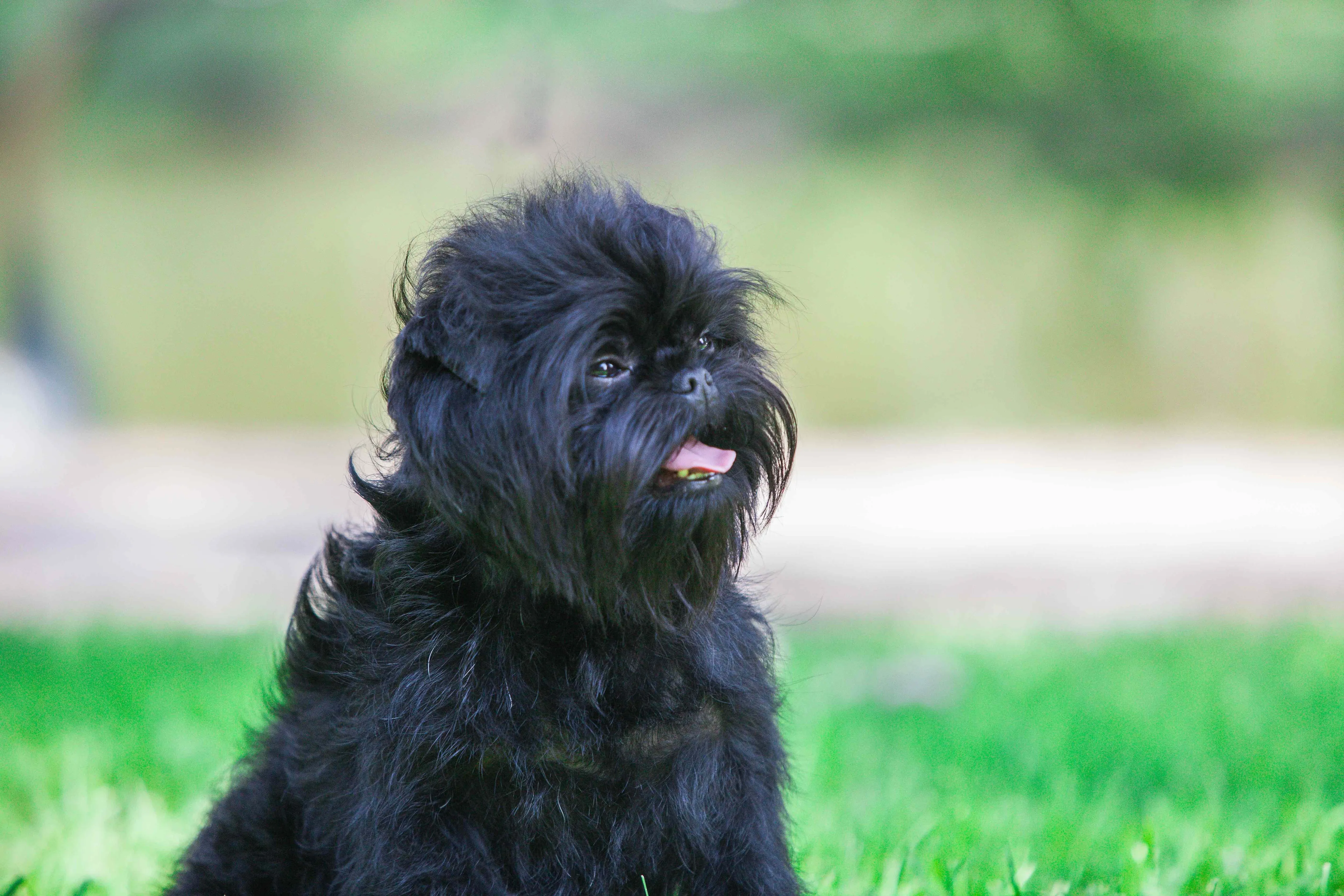 Gray and tan Afghan Hound looking at the cameraKnown for their striking elegance and distinctive long, flowing coat, Afghan Hounds are surprisingly on the list of dogs that don’t shed hair frequently. While they have a lot of hair, their coat is more like human hair and sheds minimally, similar to a Poodle. These sighthounds are built for speed and require ample exercise. Afghan Hounds are loyal and loving towards their families but can be aloof with strangers, making early socialization crucial. Their luxurious coat demands significant grooming, including daily brushing, to prevent mats and tangles.
Gray and tan Afghan Hound looking at the cameraKnown for their striking elegance and distinctive long, flowing coat, Afghan Hounds are surprisingly on the list of dogs that don’t shed hair frequently. While they have a lot of hair, their coat is more like human hair and sheds minimally, similar to a Poodle. These sighthounds are built for speed and require ample exercise. Afghan Hounds are loyal and loving towards their families but can be aloof with strangers, making early socialization crucial. Their luxurious coat demands significant grooming, including daily brushing, to prevent mats and tangles.
27. Barbet
 Close-up of a curly red Barbet dog faceThe Barbet, pronounced “bar-bay,” is a cheerful and intelligent water dog from France. Their defining feature is a shaggy, woolly, curly coat that is dense, waterproof, and low-shedding. Barbets love to swim and are active, playful companions. Their protective coat requires regular grooming, including brushing two to three times a week, especially after swimming, to keep it in good condition and prevent matting. They are known for their friendly demeanor and adaptability.
Close-up of a curly red Barbet dog faceThe Barbet, pronounced “bar-bay,” is a cheerful and intelligent water dog from France. Their defining feature is a shaggy, woolly, curly coat that is dense, waterproof, and low-shedding. Barbets love to swim and are active, playful companions. Their protective coat requires regular grooming, including brushing two to three times a week, especially after swimming, to keep it in good condition and prevent matting. They are known for their friendly demeanor and adaptability.
28. Shih-Poo
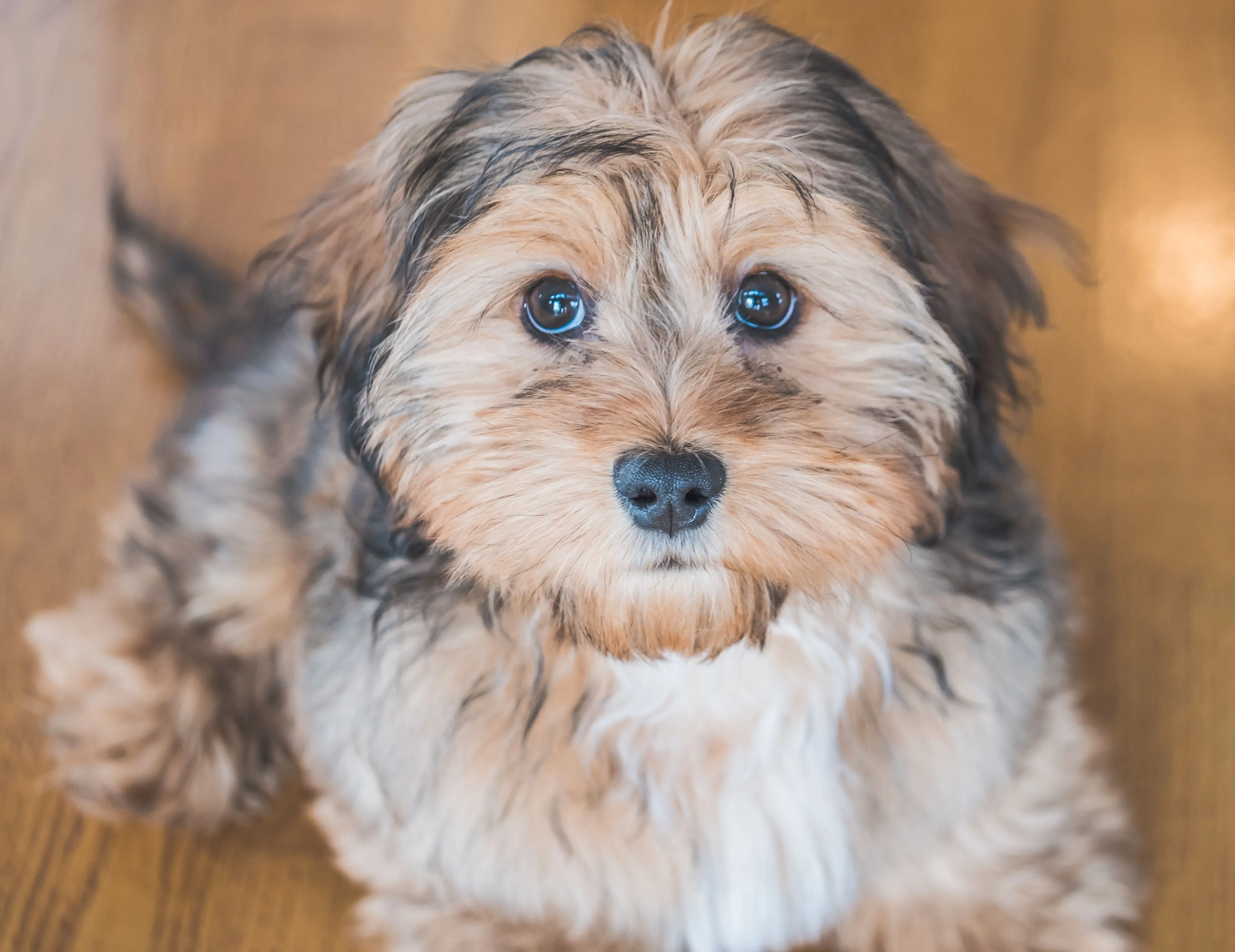 Tan and black Shih-Poo dog close-upA popular mixed breed, the Shih-Poo is a cross between a Shih Tzu and typically a Toy Poodle. This combination usually results in a small, low-shedding dog that can thrive in almost any living situation, from apartments to larger homes. Shih-Poos are affectionate, playful, and intelligent. They require daily exercise (around 30 minutes) and consistent brushing to maintain their coat and prevent tangles.
Tan and black Shih-Poo dog close-upA popular mixed breed, the Shih-Poo is a cross between a Shih Tzu and typically a Toy Poodle. This combination usually results in a small, low-shedding dog that can thrive in almost any living situation, from apartments to larger homes. Shih-Poos are affectionate, playful, and intelligent. They require daily exercise (around 30 minutes) and consistent brushing to maintain their coat and prevent tangles.
29. Peruvian Inca Orchid
 Peruvian Inca Orchid dog with spotted skinThe Peruvian Inca Orchid is an ancient and rare dog breed, serving as the national dog of Peru. Available in three sizes (small, medium, and large), they are primarily known for their hairless variety, which makes them inherently hypoallergenic due to the absence of a coat to shed dander. There is also a coated variety with a short, smooth coat that sheds very little. They are elegant, agile, and protective, forming strong bonds with their families. Skin care for the hairless variety is crucial.
Peruvian Inca Orchid dog with spotted skinThe Peruvian Inca Orchid is an ancient and rare dog breed, serving as the national dog of Peru. Available in three sizes (small, medium, and large), they are primarily known for their hairless variety, which makes them inherently hypoallergenic due to the absence of a coat to shed dander. There is also a coated variety with a short, smooth coat that sheds very little. They are elegant, agile, and protective, forming strong bonds with their families. Skin care for the hairless variety is crucial.
30. Malshi
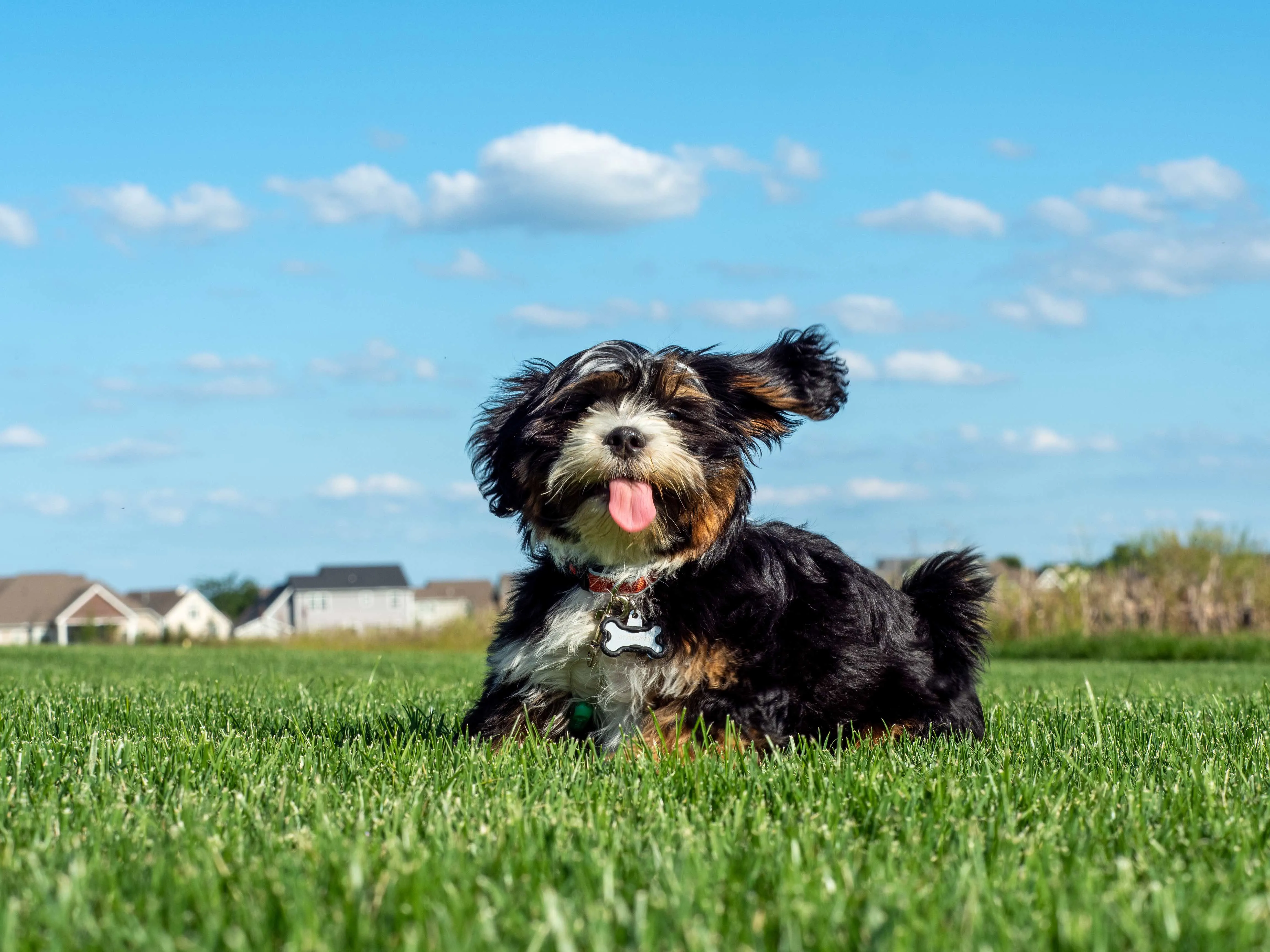 Tricolor Malshi dog in green grassThe Malshi is a delightful cross between a Maltese and a Shih Tzu, inheriting the small size and low-shedding coats from both parent breeds. These happy, affectionate dogs thrive on close companionship and are devoted to their human families. Malshis are playful and adaptable to various living environments. Like most dogs on this list of dogs that don’t shed hair, they require a dedicated, regular grooming routine, including daily brushing, to keep their long, silky coats free from mats and tangles.
Tricolor Malshi dog in green grassThe Malshi is a delightful cross between a Maltese and a Shih Tzu, inheriting the small size and low-shedding coats from both parent breeds. These happy, affectionate dogs thrive on close companionship and are devoted to their human families. Malshis are playful and adaptable to various living environments. Like most dogs on this list of dogs that don’t shed hair, they require a dedicated, regular grooming routine, including daily brushing, to keep their long, silky coats free from mats and tangles.
Essential Tips for Living with a Low-Shedding Dog
While low-shedding breeds significantly reduce allergens, responsible pet ownership and proper care are still crucial for minimizing allergic reactions and ensuring a happy, healthy environment for both you and your dog.
Consistent Grooming is Key
Even dogs that don’t shed much still require regular grooming. Their continuously growing hair can mat easily if not properly maintained, and grooming helps remove loose hairs and dander before they can spread.
- Brushing: Daily or every-other-day brushing is often recommended for many low-shedding breeds, especially those with long, curly, or woolly coats. Use appropriate brushes (slicker, pin, or comb) for their specific coat type.
- Bathing: Regular bathing (every 4-6 weeks) with a gentle, moisturizing dog shampoo can help reduce dander and keep the coat clean. Some owners use specialized anti-dander shampoos.
- Professional Grooming: Many non-shedding breeds, particularly those with continuously growing hair like Poodles or Schnauzers, require professional clipping or hand-stripping every few weeks to maintain their coat and prevent matting. Factor this into your budget or learn proper at-home grooming techniques.
Maintaining an Allergen-Reduced Home
Beyond grooming your dog, creating an allergen-reduced home environment is vital for allergy sufferers.
- Regular Cleaning: Vacuum frequently with a HEPA filter vacuum cleaner. Dust surfaces regularly with a damp cloth, and wash bedding (both yours and your dog’s) in hot water at least once a week.
- Air Quality: Utilize HEPA air purifiers in rooms where your dog spends the most time, especially bedrooms. Ensure good ventilation throughout your home.
- Designated Pet-Free Zones: Consider designating certain areas, such as the bedroom, as pet-free zones to provide a respite from allergens, particularly for sleeping.
Partnering with Healthcare Professionals
Managing pet allergies is a personal journey, and consulting with healthcare professionals is paramount.
- Consult Your Doctor/Allergist: Discuss your allergy symptoms and management strategies with your healthcare provider. They can offer advice on medications, nasal sprays, or even immunotherapy (allergy shots) to help build tolerance.
- Avoid Direct Contact with Saliva and Urine: While dander is the primary culprit, allergens are also present in a dog’s saliva and urine. Try to avoid close facial contact, and always wash your hands after handling your dog or their belongings.
Bringing a low-shedding dog into your home can significantly improve the quality of life for individuals with allergies, allowing them to experience the profound joy and companionship that only a dog can provide. By choosing wisely from a list of dogs that don’t shed hair and committing to consistent grooming and home maintenance, you can create a harmonious environment where both you and your furry friend can thrive.
References
- National Institute of Environmental Health Sciences (NIEHS). “Pet Allergens.” NIH.gov.
- PetMD.com. Various breed profiles and articles on hypoallergenic dogs and dog care.
- American Kennel Club (AKC). Breed information.
- The Barbet Club of America. Breed information.
